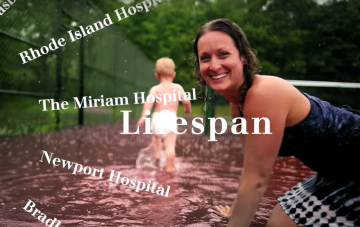The Clash of The Titans, Guest MINDSETTER™ Dr. Michael Fine
Wednesday, April 11, 2018
As healthcare institutions begin to do battle over turf and property in Rhode Island, it may be helpful for policymakers, legislatures and the public to understand a few basic principles of health policy to help sort out the truth and falsity of various claims the players are likely to make to buttress their own positions or to attack the positions of others.
First, it is worth remembering that Rhode Island has two over-riding interests at stake: the health of the public and the cost of healthcare. Medicaid and other health insurance expenditures consume about one-third of the state budget. Health insurance represents the second most significant source of overhead cost for businesses. Decisions we make about health policy that affect what we spend on health insurance impacts the need for taxation and the business climate. We should be focused on improving health outcomes, achieving optimal health for all Rhode Islanders, and reducing health care cost by the efficient organization of health services. Nothing else really matters.
Second, the more medical services we have available, the more those services will be used and the greater our costs become. Build more hospitals or hospital beds, and more will be used, generating more costs. Have more ambulances, and more ambulances will be used to make more ambulance runs. Each of those ambulance runs will generate an emergency department visit and some will generate hospitalization, many of which will improve the health of the transported, but some will not. (One estimate suggests about 50 percent of Emergency Department visits in Rhode Island could have been well cared for in a much less expensive primary care setting.) The challenge of health policy is to determine how much of each service is needed to address the burden of disease and injury we actually experience, and not more, and to choose services that are most cost-effective for each disease and condition.
GET THE LATEST BREAKING NEWS HERE -- SIGN UP FOR GOLOCAL FREE DAILY EBLASTThird, hospitals are more about jobs then they are about health outcomes. There is no evidence that the number and location of hospital beds has any significant impact on public health outcomes; some evidence that more hospital beds produce more cost; and some evidence that hospitalization is associated with inherent risk (from infectious diseases acquired in the hospital, and from misadventures from procedures that are only performed in the hospital, and that are more likely to be performed unnecessarily when we rely on hospitalization for first-line care.) That said, there are a few diseases and conditions that have better outcomes when regionalized, and others for which rapid treatment produces better outcomes. The absence of evidence doesn’t mean that the number and location of hospital beds have no impact on public health outcomes, but only that any public health outcomes is hard to measure. Even so, we’ve got to be mindful that 65 or so percent of hospital income is public money – Medicare and Medicaid, and we’ve got to ensure that public funds are spent in the public interests, not solely to generate private profit.
Fourth, there is an inherent tension between the need for regionalization and the need for rapid treatment. The underlying principle of regionalization is that practice makes perfect. The more experienced clinicians have with some less common diseases and conditions, the more skilled they become at treating those diseases, and regionalization brings together a critical mass of patients with specific diseases and conditions so that expertise can develop, and quality can be measured and improved. We have long known that the regionalization of neonatal intensive care, for example, produces better outcomes. The driver of rapid treatment is that time and distance are critical factors for survival in some situations, like profuse bleeding and chest injury after trauma, or in cases of heart attacks and strokes. It takes planning, organization and the organized deployment of resources to make sure that the conditions benefiting from regionalization are in fact regionalized, and to make sure that rapid treatment is available for conditions that require speed. Rhode Island does relatively little of that planning and organization now. We are a home rule state, which means every municipality has its own emergency dispatch and ambulance providers, who are a hodgepodge of public, volunteer and private services. Our hospitals are independent entities competing for business, with private self-appointed boards, when they are non-profits, who are accountable only for their errors. There is no real authority that organizes and divides the work in a rational way, or that designs a rational delivery system based on the incidence and prevalence of disease.
Fifth, there is likely some value, from the perspective of effective health professional training, jobs, research and the jobs that research may produce, in consolidating the work of Rhode Island Hospital, Women and Infant’s Hospital, Butler Hospital, Brown’s Warren Alpert School of Medicine, and URI’s Nursing and Pharmacy Schools, RIC’s Nursing and Social Work Schools, and training programs in laboratory science and physical and occupational therapy. The likely value in such a consolidation flows from an ability to achieve efficiencies of scale and to develop expertise in multi-disciplinary team function: we’ll be able to attract the best teachers and researchers in a place that has more resources; and we’ll be to develop more effective multidisciplinary practice teams when we give health professional students the experience of working together as students. There is likely to be some patient care value that flows from this coordination as well but also some downside risk: it may be less satisfying to be a patient in a very larger organization focused on teaching and research. On the other hand the strength of Rhode Island health care, outside of the primary care arena in which we have developed some depth, may well be the tunnel that connects Rhode Island and Women and Infants’ Hospital, which represents a long and deep clinical collaboration focused on patient care, a clinical collaboration that survives in the face of corporate battling.
All hospital consolidations are associated with increased cost, as the consolidated entities exert their monopoly power in negotiations with insurance companies and large employers. Some will argue that antitrust concerns prevent hospital consolidations. But monopoly power and anti-trust concerns can be mitigated by state regulatory action: we could likely get out from under antitrust concerns by creating a hospital regulatory commission that sets rates and budgets if we determined that hospital consolidation is in the public interest, which is exactly what we do with electric power and the PUC. Hospitals, of course, want to have their cake and eat it: they want consolidation but will fight any regulation tooth and nail. Wise public policy should take on and defy that resistance.
It is irresponsible to allow any hospital consolidation without devoting attention and public resources to the organization and function of our primary care delivery system. Primary care functions as the check and balance of the hospital system. When we have one primary care practice for every 10,000 people open from 8 am to 8 pm and open on weekends, and when we enroll all Rhode Islanders in such a primary care practice, we can reduce emergency room and hospital utilization significantly – perhaps even in half – and improve all measurable public health outcomes.
What about Boston? One the one hand, diseases and conditions that occur infrequently, likely less than in 50 or 100 people per million, or less than one in 10,000 to 20,000, should be cared for at a regional center like Boston: we’ll never develop the critical mass of experience to care for those diseases and conditions effectively, despite any desire to do so. For those people, who may number several hundred or a few thousand in total, we should pool our resources and figure out how to get them to Boston comfortably for care. It’s no fun getting stuck on Route 95 when you are sick. But for everyone else, we should try to provide their care in Rhode Island, even if that means consolidating hospitals to do so. Our economy is still fragile. We need those jobs here. Our parochialism may appear quaint to some, but it gives us our character. Allowing bureaucrats in Boston who are out of the reach of our legislative jurisdiction to have control of our health care decision making undermines our ability to self-govern, and undercuts our democracy. Collaborate when indicated? Absolutely. But allow the expropriation of our resources into a setting where we have no voice? Never. We joined a revolution to prevent taxation without representation, which is what moving ownership of our hospital system to Boston represents.
But resisting the Boston option isn’t enough. Boston or no Boston, we still have to drive ourselves to achieve efficiencies in our health care delivery system. We have to both plan and execute. We have to build a right-sized balanced delivery system, informed by data on the incidence and prevalence of disease and data on the most effective and cost-efficient health services. We need intelligent regulation of health professionals and healthcare institutions. We need public control of public expenditures. And we need to keep our focus on providing optimal health for all Rhode Islanders, eliminating unnecessary services and costs, and using any money we save to strengthen our communities by building better education, safe and healthy housing, community services, a clean environment and safe streets, which, at the end of the day, is what actually matters for health.
Michael Fine M.D. is Chief Health Strategist for the City of Central Falls and Senior Clinical and Population Health Officer at Blackstone Valley Health Care, Inc. He was Director of the Rhode Island Department of Health 2011-2015.
Related Slideshow: 7 Implications and Unintended Consequences of a Care New England and Partners Merger
Related Articles
- RI Insurance Commissioner Says Healthcare Costs Will Likely Increase if Partners Buys CNE
- Sasse Talks Growing RI Economy and Says Partners HealthCare Deal May Be Beneficial
- Raimondo and Mattiello Back-to-Back on LIVE - Talk PawSox, Partners Health, and $1B for Schools
- RI Commerce’s Pryor Concerned About RI Job Loss if Partners Buys Care New England
- Boston’s Partners HealthCare Moves Forward to Absorb Care New England, Faces Opposition in RI
- LIVE: Neronha on Immigration, Partners HealthCare, Brady Sullivan, & More
- Healthcare Merger Mania - Is Lifespan Next for Boston’s Partners HealthCare?
- Whitcomb: Partners Expanding Its Expansionism? Time to Take on New Gilded Age Monopolies
- Whitcomb Warns of Lifespan Entering a Care New England-Partners Deal on LIVE
- Care New England Signs Agreement With Partners Healthcare for Potential Merger
- 7 Implications and Unintended Consequences of a Care New England and Partners Merger
- LIVE: Prov Based G-Form Partners with Red Sox, Continues Innovative Sports Protection Technology
- Care New England, Partners HealthCare Extend Letter of Intent Through Jan. 2018
- Brown Opposes Care New England Sale to Partners, Teaming with Prospect
- Partners HealthCare and Care New England Deal Has a New Wrinkle - Lifespan
- Partners, Proposed Purchaser of Care New England in RI, Is Outsourcing High Tech Jobs to India















